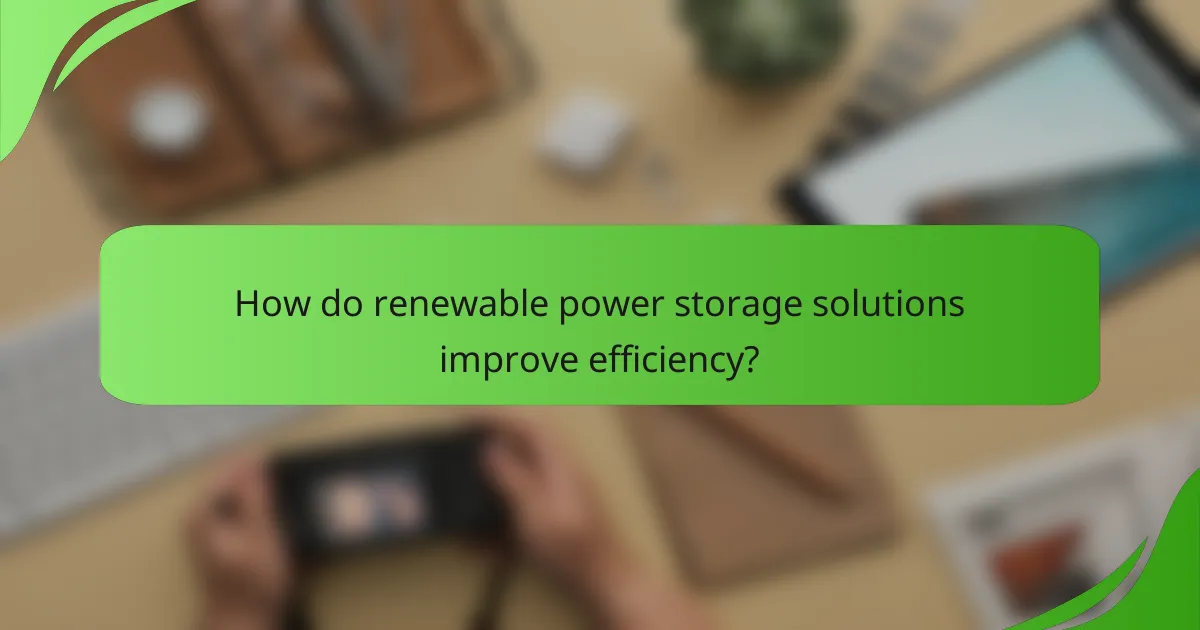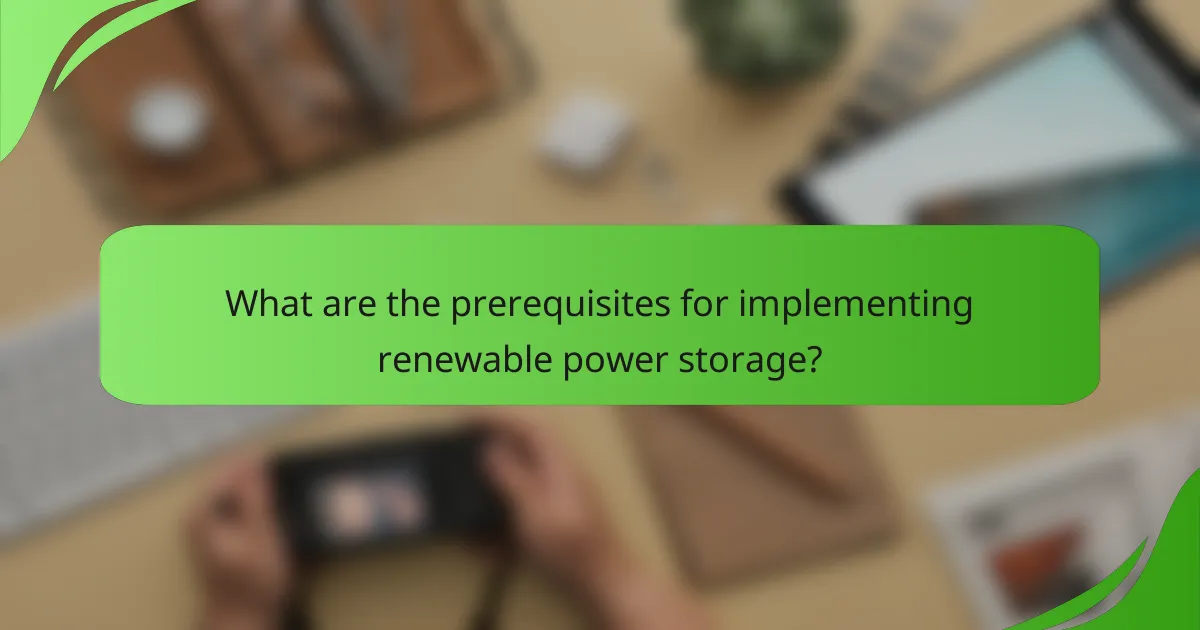Renewable power storage solutions are essential for optimizing the use of clean energy sources, enabling the capture of excess energy during peak production and its release during high demand. Technologies such as lithium-ion batteries, pumped hydro storage, and compressed air energy storage each offer distinct advantages in terms of efficiency, scalability, and affordability. As the demand for renewable energy continues to grow, understanding these storage options becomes crucial for a sustainable energy future.

What are the best renewable power storage solutions in the USA?
The best renewable power storage solutions in the USA include lithium-ion batteries, pumped hydro storage, flow batteries, compressed air energy storage, and solid-state batteries. Each of these technologies offers unique advantages and considerations for efficiency, scalability, and affordability in the context of renewable energy integration.
Lithium-ion batteries
Lithium-ion batteries are the most widely used storage solution for renewable energy, particularly in residential and commercial applications. They are known for their high energy density and relatively low self-discharge rates, making them effective for short to medium-term energy storage.
When considering lithium-ion batteries, it’s essential to evaluate their lifespan, which typically ranges from 5 to 15 years, and their cost, which can vary significantly based on capacity and manufacturer. They are ideal for applications requiring quick response times, such as grid stabilization and peak shaving.
Pumped hydro storage
Pumped hydro storage is a mature and scalable technology that uses two water reservoirs at different elevations to store energy. During periods of low demand, excess energy is used to pump water uphill, and during high demand, the water is released to generate electricity.
This method is highly efficient, with round-trip efficiencies often exceeding 70%. However, it requires significant geographical considerations and substantial initial investment, making it more suitable for large-scale projects rather than individual installations.
Flow batteries
Flow batteries store energy in liquid electrolytes contained in external tanks, allowing for scalable and flexible energy storage solutions. They are particularly advantageous for long-duration storage, with the ability to discharge energy over several hours or even days.
While flow batteries typically have lower energy densities compared to lithium-ion batteries, they offer longer lifespans and can be cycled many more times without significant degradation. This makes them suitable for applications like renewable energy integration and grid support.
Compressed air energy storage
Compressed air energy storage (CAES) involves storing energy by compressing air in underground caverns or tanks. When energy is needed, the compressed air is heated and expanded to drive turbines and generate electricity.
CAES systems can provide large-scale storage and are particularly effective for balancing supply and demand in the grid. However, they require specific geological formations for storage and can have higher capital costs compared to other technologies.
Solid-state batteries
Solid-state batteries represent an emerging technology that uses solid electrolytes instead of liquid ones, potentially offering higher energy densities and improved safety. They are still in the development phase for many applications but show promise for future renewable energy storage.
These batteries could reduce risks associated with flammability and enhance performance in extreme temperatures. As research progresses, solid-state batteries may become a viable option for both consumer electronics and larger-scale energy storage systems.

How do renewable power storage solutions improve efficiency?
Renewable power storage solutions enhance efficiency by capturing excess energy generated during peak production times and releasing it during periods of high demand. This process ensures a more reliable and balanced energy supply, reducing the need for fossil fuel backup systems.
Enhanced energy management
Effective energy management is crucial for optimizing the use of renewable resources. Storage systems allow for the strategic deployment of energy, enabling utilities and consumers to utilize stored power during peak hours when electricity prices are higher. This can lead to significant cost savings and improved grid stability.
For instance, battery storage can be deployed alongside solar panels to store energy generated during sunny days for use at night, maximizing the utility of renewable sources.
Load balancing capabilities
Load balancing is essential for maintaining a stable energy grid, especially with the variable nature of renewable energy sources. Storage solutions help smooth out fluctuations in energy supply and demand, allowing for a more consistent flow of electricity. This capability is particularly important during sudden spikes in demand or drops in generation.
By integrating storage systems, energy providers can respond quickly to changes in load, ensuring that supply meets demand without resorting to less efficient energy sources.
Reduced energy waste
Renewable power storage solutions significantly reduce energy waste by capturing surplus energy that would otherwise be lost. For example, during periods of low demand, excess energy generated from wind or solar can be stored rather than curtailed, ensuring that it is available when needed.
Implementing these systems can lead to a more sustainable energy model, where less energy is wasted, and the overall efficiency of the grid is improved. This not only benefits consumers but also contributes to broader environmental goals by minimizing reliance on fossil fuels.

What factors influence the scalability of renewable power storage?
The scalability of renewable power storage is influenced by technology maturity, infrastructure requirements, and market demand. Each of these factors plays a crucial role in determining how effectively storage solutions can be expanded to meet growing energy needs.
Technology maturity
The maturity of storage technology significantly impacts scalability. Advanced technologies like lithium-ion batteries and emerging solutions such as solid-state batteries offer varying levels of efficiency and longevity. As these technologies evolve, their ability to store larger amounts of energy at lower costs improves, making them more scalable.
For example, while lithium-ion batteries dominate the market today, newer technologies may provide better performance and safety, which could encourage wider adoption and scalability. Understanding the current state of technology helps stakeholders make informed decisions on investments and implementations.
Infrastructure requirements
Infrastructure plays a vital role in the scalability of renewable power storage. Adequate facilities for manufacturing, deploying, and maintaining storage systems are essential. This includes everything from production plants to charging stations and grid connections.
In many regions, existing infrastructure may need upgrades to accommodate larger storage systems. For instance, integrating storage solutions with smart grid technology can enhance efficiency and reliability, but it requires significant investment and planning.
Market demand
Market demand directly influences the scalability of renewable power storage solutions. As the push for renewable energy increases, so does the need for effective storage options to balance supply and demand. High demand can drive innovation and lower costs, making it easier to scale solutions.
For example, regions with aggressive renewable energy targets may see faster development of storage technologies and infrastructure. Stakeholders should monitor market trends and regulatory changes to anticipate shifts in demand and adapt their strategies accordingly.

How affordable are renewable power storage solutions?
Renewable power storage solutions are becoming increasingly affordable, driven by technological advancements and economies of scale. While initial investments can be significant, the long-term benefits often outweigh the costs, especially as prices continue to decline.
Cost of lithium-ion batteries
Lithium-ion batteries are the most common storage solution for renewable energy, and their costs have dropped dramatically over the past decade. Currently, prices range from around $100 to $200 per kilowatt-hour, depending on the scale and manufacturer. This reduction in cost is largely due to increased production and improvements in battery technology.
When considering lithium-ion batteries, it’s essential to evaluate their lifespan and efficiency. Most batteries can last between 10 to 15 years, with warranties often covering a significant portion of that time. However, performance may degrade over time, impacting overall cost-effectiveness.
Government incentives
Many governments offer incentives to encourage the adoption of renewable power storage solutions. These can include tax credits, rebates, and grants that significantly lower the upfront costs for consumers and businesses. For example, in the United States, the federal investment tax credit (ITC) allows for a percentage deduction on solar energy systems, which can include storage components.
It’s crucial to research local and national programs, as incentives can vary widely by region. Some countries in Europe, like Germany and France, have robust support systems that can make renewable storage solutions more financially viable.
Long-term savings on energy bills
Investing in renewable power storage can lead to substantial long-term savings on energy bills. By storing excess energy generated during peak production times, users can reduce reliance on grid power during high-demand periods, which often come with higher rates. This can result in savings of 20% to 50% on electricity costs over time.
Additionally, many regions are moving towards time-of-use pricing, where electricity rates vary based on demand. Having a storage solution allows consumers to take advantage of lower rates during off-peak hours, further enhancing savings. It’s advisable to calculate potential savings based on local energy prices and usage patterns to determine the best approach for individual circumstances.

What are the prerequisites for implementing renewable power storage?
Implementing renewable power storage requires careful consideration of several key factors, including site assessment, regulatory compliance, and financial analysis. Each of these elements plays a crucial role in ensuring the successful integration of storage solutions into renewable energy systems.
Site assessment
A thorough site assessment is essential for determining the feasibility of renewable power storage. This involves evaluating factors such as geographical location, climate conditions, and proximity to energy generation sources. For instance, areas with high solar or wind potential are ideal for solar and wind energy storage systems.
Additionally, the assessment should include an analysis of existing infrastructure and grid connectivity. Understanding the local energy grid’s capacity to handle additional storage can help in planning and optimizing the system’s performance.
Regulatory compliance
Compliance with local, state, and federal regulations is critical when implementing renewable power storage solutions. This may involve obtaining necessary permits, adhering to safety standards, and following environmental regulations. Each jurisdiction may have specific requirements that must be met before installation can begin.
It is advisable to consult with local authorities or regulatory bodies to ensure all legal obligations are fulfilled. This can prevent costly delays and ensure that the project aligns with regional energy policies and incentives.
Financial analysis
A comprehensive financial analysis is vital to assess the viability of renewable power storage projects. This includes evaluating initial investment costs, ongoing maintenance expenses, and potential savings from energy efficiency. Understanding the total cost of ownership can help in making informed decisions about which storage technologies to pursue.
Consideration of available financing options, such as government grants or incentives, can also impact the overall financial feasibility. Conducting a cost-benefit analysis will provide insights into the expected return on investment and help prioritize projects that offer the best economic benefits.
